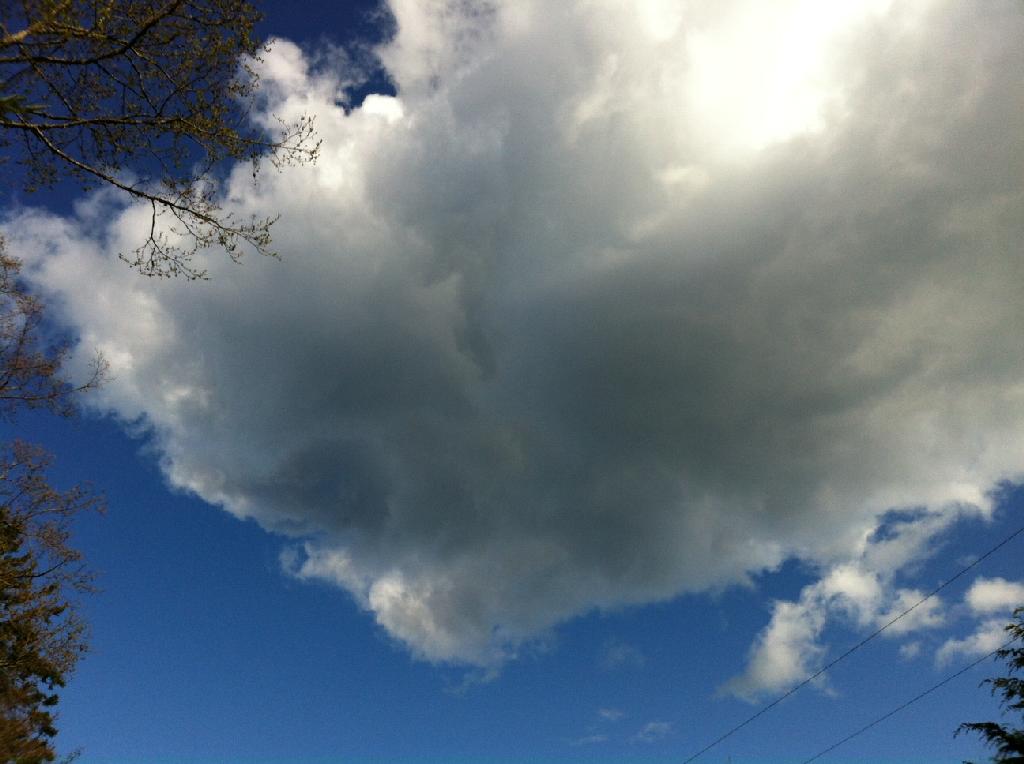
April sky over Colvos Passage
It’s hard not to notice a spring sky. Like throw pillows of the gods, towering piles of cumulus clouds dominate the horizon. Or they loom ominously overhead like bulbous gray zeppelins, warning us not to get too attached to the parts of the sky that remain blue. I love how the sun catches cloud edges—creating a literal silver lining, while the shadowy undersides do a poor job of hiding their “precipitatory” intent. And who can resist the flying-saucer-like, weather-predicting lenticulars that cap Mt. Rainier on pre-rain days? As the saying goes, “If Mt. Rainier puts on her bonnet, it’s going to rain, doggone it!”
Water floating on air
What are clouds? Most commonly, they form when air rises and expands at higher altitudes. The rising air carries water in a gas form, or water vapor. When its temperature lowers to what is known as “dew point,” the water vapor condenses, changing into liquid form. The resulting mass of water droplets form clouds that we can see. A cloud is made up of billions upon billions of miniscule droplets of water—so small that they literally float on air. On a spring afternoon in our area, cloud scientists routinely measure more than 500 million water droplets per cubic meter of cloud!
Spring is a cloud-watcher’s delight. The differences in temperature between the rapidly warming Earth and the still wintry upper atmosphere make for some noteworthy cloud days. Now is the time to grab a friend, flop down on your back (if the grass isn’t too wet from the last hail, rain or other shower) and play the cloud naming game—“I see a man riding a poodle,” and so on. Watching clouds is a respectable way to slow down, appreciate gravity, tune-up your imagination, and play.
A book for cloud lovers
Recently I ran into another good excuse to watch clouds. Just when I was making a pretty convincing effort trying to believe, “I really don’t need any more guidebooks,” one came along to prove me wrong. It’s The Cloud Collector’s Handbook—a staple at Vashon Bookshop. Authored by The Cloud Appreciation Society Founder Gavin Pretor-Pinney, this book offers the perfect balance of facts and fun.
In addition to providing photos and ID tips for the 10 main cloud types including cirrus and stratus, the handbook covers “notable species & varieties,” “accessory clouds,” and “cloud optical effects,” like rainbows, sun pillars, sun dogs and something called a “circumzenithal arc.” This crazy upside-down rainbow is now at the top of my cloud quest list, and it’s worth 45 cloud-collecting points! That’s another addicting aspect of this little book: Every cloud you see is worth a certain number of set points. From the easy-to-spot and common cumulus worth 15 points, to the rare and fleeting wave-like Kelvin-Helmholtz, at 55 points! Every cloud type is accompanied by a place for the collector to note the time, location and weather on the day they bagged their latest airborne prize. With stunning photos and the science behind the phenomena all narrated with a sharp British wit, this is also an absorbing armchair book.
If you live in the Northwest, chances are that if you look outside your window right now, you’ll see a cloud. So, what are you waiting for? Get out there and collect it! Or, just lie back, gaze at the spring sky and let your imagination run wild.

